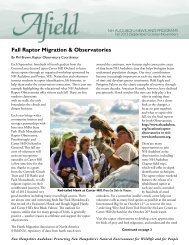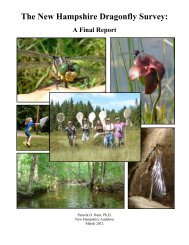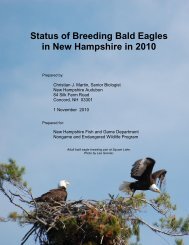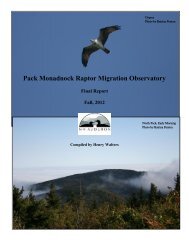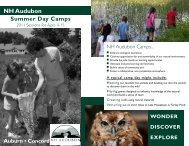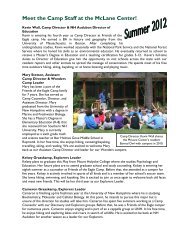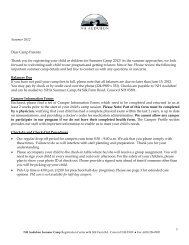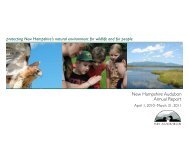Carter Hill Raptor Observatory - New Hampshire Audubon
Carter Hill Raptor Observatory - New Hampshire Audubon
Carter Hill Raptor Observatory - New Hampshire Audubon
You also want an ePaper? Increase the reach of your titles
YUMPU automatically turns print PDFs into web optimized ePapers that Google loves.
Black Vulture (Coragyps atratus)<br />
Season Total: 1 (September 21) * 1 st Site Record<br />
The site‟s first – and, as it turned out, Concord‟s first – black vulture was spotted by Phil Brown<br />
as it soared with two turkey vultures on a hazy late September afternoon. Sam Lewis and Bob Quinn<br />
were also on hand, and Bob, who has a lifelong passion of studying birds in Concord, had excellent<br />
timing, arriving just in time to observe a few of the vulture‟s characteristic quick flaps. Though it<br />
appeared that this flight strategy would bring the bird nowhere on such a soupy day, the three vultures<br />
were indeed migrating along a southwestern trajectory typical of the vultures seen from <strong>Carter</strong> <strong>Hill</strong>. The<br />
sighting of a black vulture is still cause for excitement among <strong>New</strong> <strong>Hampshire</strong>‟s birding community,<br />
but with this species‟ northward expansion, it may only be a number of years before this bird becomes a<br />
regular visitor to the hawk watch.<br />
Black (left) and turkey (right) vultures. Photo by Phil Brown<br />
Turkey Vulture (Cathartes aura)<br />
Season Total: 223 High Count: 95 (Oct. 9)*<br />
The classic “V” of a turkey vulture's dihedral was a frequent sight teeter-tottering over the<br />
hawkwatch. Local birds made their daily appearances through the first half of the season, their numbers<br />
augmented, then replaced by migrants. The peak of migration occurred between Oct. 5 th and Oct. 13 th<br />
with 145 turkey vultures counted. Two sizable kettles were observed on 10/9, one of 45 birds, clouding<br />
a thermal like giant, melanistic broad-winged hawks. The rather ghastly appearance of a close perched<br />
turkey vulture is lost when the bird becomes airborne, transforming into a master soarer capable of<br />
riding the faintest puff of breeze or stiffly-blowing gale with equal grace. Turkey vultures continue to<br />
expand their range northward through <strong>New</strong> England and beyond every year.



